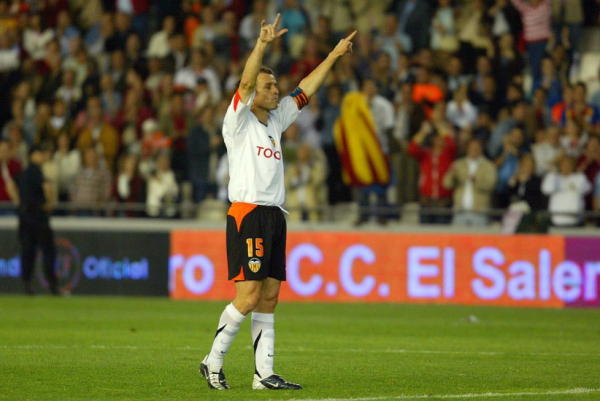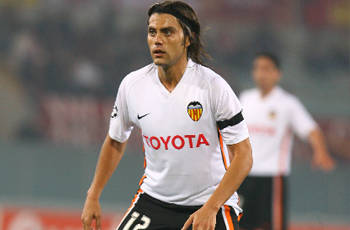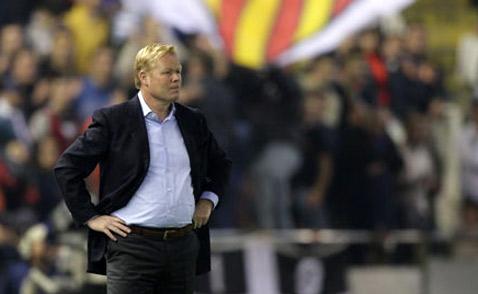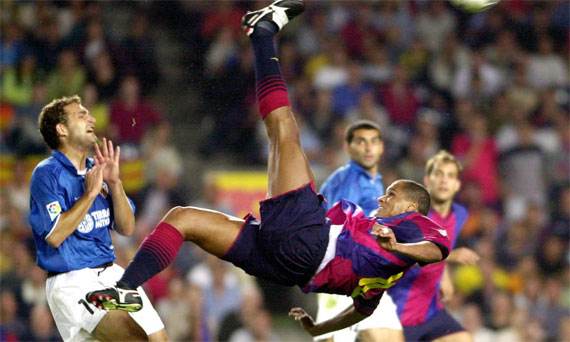THE
LONGEST SEASON
Valencia squad celebrating the Copa del Rey
1998-99 season will always be remembered by
Valencia CF fans due to several facts: during the season, the stadium fences
were removed, it was the last season that the players wore black socks and, of
course, it was the season in which the team won the first trophy since the
European Supercup in 1981: the Copa del Rey. For many fans, it meant the first
title that they witnessed in their lives. But the season was hard and, above
all, very long. 64 games divided among La Liga, Copa del Rey, UEFA Cup, Intertoto
Cup and several friendlies.
The season began sooner than expected, in the
beginning of July 1998, because Valencia CF had to qualify for the UEFA Cup via
Intertoto Cup, the last chance that UEFA gave the clubs to get a spot in that
competition if they hadn’t taken care of business in the previous season in their
leagues.
The previous season had been a little tumultuous.
Jorge Valdano got fired in game 3 after three losses and also due to a stupid
mistake in Santander, when he introduced four non-EU men in the pitch, when
only three were allowed. There also was a radical style change with his
substitute, the Italian Claudio Ranieri, from a more creative one that Valdano
displayed to the defensive and intense one that Ranieri used. Most of the
players that had been signed in the summer had ended up being a terrible
fiasco, as was the case of Moussa Saïb, Marcelinho Carioca, Morigi, Campagnuolo
or Del Solar; apart from that, the club failed in rehabbing Romário for the
second time. And last, but not least, the president Paco Roig resigned from his
position, being replaced by his advisor Pedro Cortés.
The team ended the season 9th in the
standings, four points shy from a UEFA Cup spot. Still, the team showed some
good performances in the second half of the season: the team won at the
Bernabeu and Camp Nou (this one was epic), there was a newcomer player who
performed at a world class level, the Romanian Adrian Ilie, the Argentinean
Claudio López had an exciting progression and a box-to-box player who had spent
the previous five years unnoticed finally exploded: Gaizka Mendieta. Apart from
that, there was a veteran core that sustained the team, such as Carboni,
Angloma, Djukic and Milla.
 |
| Ilie after scoring a goal against Steaua Bucharest |
Therefore, Valencia CF had to do their homework in
July and signed a bunch of players to achieve their goal. The club acquired an
Italian classic forward, Cristiano Lucarelli, from Atalanta, who didn’t succeed
at Mestalla despite being the top scorer of Serie A with Livorno a few years
later. They also signed a central defender from PSG, who played outstandingly,
the former French international Alain Roche. A couple of Romanian players were
signed, too, one of them having played a fantastic season for UD Salamanca the
previous year and who also participated in the 1998 FIFA World Cup held in
France: Gabi Popescu; the other Romanian player was a strange signing since,
from the very moment he was presented as a new Valencia CF player, he showed no
talent at all, unable to do three douches in a row with the ball in his feet,
but he was the brother of one of the stars of the team: Sabin Ilie, Adrian’s
brother, who was told he was the better of the both; he spent a few months and
didn’t play a single minute for the club. Two Swedish players landed in
Valencia in that summer, who had optimal performances: the long range shooting
specialist Stefan Schwarz and the sober-minded central defender Joachim
Björklund, the latter being an important asset for the team in the following
three years. Téllez was also another new signing, a robust defender from
Alavés, who only played one game for Valencia CF. More onwards, in the winter
transfer window, Valencia CF signed another Romanian, Dennis Serban, who was
unsuccessful at Mestalla. But the best signing of the season was that of goalkeeper
Santiago Cañizares, who replaced retired Andoni Zubizarreta; he came as a free
agent from Real Madrid and his story with Valencia CF is well known in his ten
year spell at the club.
Even so, as some of the new signings hadn’t lived
up to the expectations, most of the players who already were in the roster had
to step up and progress the way they were expected to. There was a lot of
excitement among fans, so much that president Pedro Cortés, in the team’s
presentation before the supporters, asserted that the Geperudeta (the Virgin of
Desamparados, the patron saint of the city) had told him that the team would
win a trophy that season.
The team had a good start in the Intertoto Cup. Fortunately,
as he had a long ban in La Liga which meant that he couldn’t play the first five
games of the competition, Claudio López didn’t go on holidays after finishing
his participation with the Argentinean national team in the World Cup; he went
straight to practise to help the team qualify for the UEFA Cup. Valencia CF
knocked out Shinnik Yaroslavl, a weak Russian team, playing their away game at
a stadium that was more like a swimming pool, with Mendieta requiring help from
a teammate to be able to kick a corner, a funny image. They also won Marcelo
Bielsa’s RCD Espanyol, full of youngsters from their youth system, among which
future stars could be found: Capdevila, Tamudo or Sergio González. Valencia CF
finally won the final against Casino Salzburg (currently known as Red Bull
Salzburg).
Valencia CF seemed to be working well and was
fully fit to start La Liga season solidly. Besides, there was an extra
motivation that year: that was the first season in which the top 4 of La Liga
would get a spot for the following Champions League and the team looked a good
contender and one of the favorites.
Ranieri’s playing style was pretty simple and
Italian-like: strong defense, playing with three central defenders and two
wings in some games and a powerful counterattack, exploiting Claudio López’s
speed and Ilie’s talent. It was a style the team felt comfortable with when
they played against big clubs who had to control the games, but the team
suffered against weaker teams who used a more defensive style.
Valencia CF started the season at home against a
difficult team, who had spent a lot of money in new signings, Arrigo Sacchi’s
Atlético Madrid. The team won thanks to a single goal by Miguel Ángel Angulo,
which certified the ambition of the team to be in the top positions. But in
away games the team seemed to be weak and found it difficult to play well and
get results. Claudio López came back from his ban in October, and he did it
against his favorite opponent, Louis Van Gaal’s FC Barcelona, at Mestalla, in a
game in which a wonderkid made his debut in La Liga for the Catalans: none
other than Xavi Hernández. Barça won 1-3, showing that Valencia CF was still a
little immature to compete against the previous year’s La Liga champion. But from
that game on, the team started to win home and away games, eventually reaching
the top 4, which gave a spot for the Champions League.
The team also started the UEFA Cup, thanks to
their performance in the Intertoto Cup in July. Their first opponent was
Romanian Steaua Bucharest, where the before mentioned Dennis Serban played for.
Valencia CF won the tie easily and, in the next round, they would have to play
against one of the big clubs in Europe, Liverpool FC. It was a fantastic
opportunity to be measured against one of the most attractive and historical
teams in Europe. Liverpool FC had very talented players, such as McManaman,
Fowler, Ince and the English wonderkid of the time, Michael Owen. The double
value of away goals was the only thing that gave Liverpool FC the
qualification; Valencia CF was a great competitor but was knocked out without
losing any of both legs. The team had to focus on La Liga.
The progress of the team was so good that, at the
end of the first half of the competition and after two wins at RCD Mallorca’s
Lluis Sitjar and Atlético Madrid’s Vicente Calderón, Valencia CF could be
considered as a solid contender for the lead of La Liga. But a series of
unexpected losses moved the team away from the title fight.
In these days, the team started their
participation in Copa del Rey. To begin with, there was a regional derby
against Levante UD, that was in the third category of Spanish football at those
times; Valencia CF had no problems in defeating them. February offered three
duels in only ten days against FC Barcelona, since they would be the following
opponents in the quarter-finals of Copa del Rey. That time, Valencia CF did
compete. And how! A 2-3 win at Camp Nou in the first leg (with a memorable goal
by Mendieta after a corner); at Mestalla, Valencia CF certified its qualification
by winning 4-3; and a few days later, in their La Liga game, Valencia CF won at
Camp Nou again, 2-4 this time. And these results had a common denominator:
Claudio López, “el Piojo” (the
louse): six goals in three games. He had
taken the measure to Van Gaal who, thanks to his stubbornness, using the same
system over and over again, let the Argentinean feel comfortable, and Claudio
took advantage from it, destroying Frank de Boer, Abelardo, Sergi and
Pellegrino.
 |
| Claudio López celebrating a goal against Barcelona |
In La Liga, Valencia CF continued its path
regularly, with big wins at the previously mentioned Camp Nou, and also at San
Mamés in Bilbao, combined with surprising point losses against weaker opponents
like Rafa Benítez’s Extremadura.
In June, the team was battling for a Champions
League spot and their opponents were RCD Mallorca and Celta Vigo and, in the
Copa del Rey semifinals, Valencia CF had to face Real Madrid. The result of
that tie is well known, one of the club’s biggest wins against “los merengues”. The final score in the
first leg at Mestalla was 6-0 and supporters ended the game comparing Real
Madrid with the weak San Marino national team, who had just conceded the same
amount of goals in their game against Spain a few days before. The second leg
was perfunctory. Atlético Madrid awaited in the final.
 |
| Mestalla's scoreboard with the final result of the Copa del Rey game against Real Madrid |
Meanwhile, Valencia CF’s qualification for the
following season’s Champions League was in jeopardy; the team lost against
relegated Tenerife in the penultimate game, so Valencia CF had to depend on
others to achieve their purpose. The opponent for that spot was Celta Vigo and
Valencia CF had a home game against Héctor Cúper’s astounding RCD Mallorca, who
had mathematically qualified for the Champions League. Valencia CF had to win
and hope that Celta would lose their home game against Atlético Madrid. And
that’s what happened. Valencia CF won their game and Atlético defeated Celta at
Balaídos, which gave the “colchoneros”
a spot for the following season’s UEFA Cup because, as Valencia CF had
qualified for the Champions League, the Copa del Rey runner-up would play the
European second most important competition; and, if Valencia CF had failed, the
qualified team for the UEFA Cup would have been the 7th in La Liga.
Hence, a big party started at Mestalla, with Claudio López running around the stadium
with a “senyera” (the Valencian flag)
on his shoulders. People thought he was saying goodbye. A lot of big clubs had
a serious interest in signing him and Valencia CF had to do their best to keep
him. But they did and he stayed for one more season. It was Claudio Ranieri’s
farewell, who had decided to leave and sign for Atlético Madrid; the Italian
would be replaced, curiously, by Héctor Cúper.
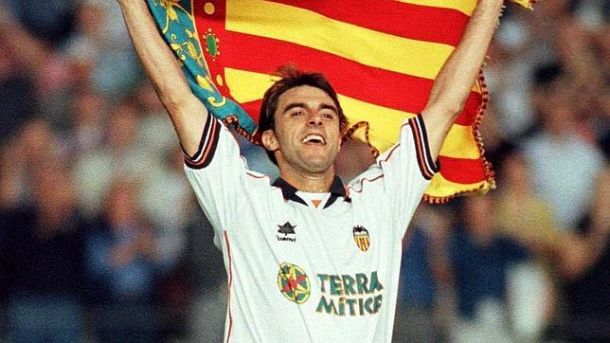 |
| Claudio López, with the "Senyera" on his shoulders |
June 26, 1999 was the big day. Valencia CF reached
the Copa del Rey final, that would take place at La Cartuja stadium, in Seville.
The team arrived stronger than ever and Atlético had serious doubts about their
possibilities. Their path in La Liga had been inconsistent. Sacchi had been
fired in the middle of the season and had been replaced by Serbian Radomir
Antic, and they had finished 13th. Valencia CF showed an amazing
superiority from the first to the last minute of the game. Claudio López showed
a fantastic form, scoring two wonderful goals, but the star of the game was
Gaizka Mendieta. His goal was extraordinary; it can’t be explained with words, considered
one of the most beautiful in history. Valencia CF won the game 3-0; twenty
years later, the team took the trophy home, and it also had been eighteen years
without a title in Valencia. The city of Valencia received their players the
way champions deserve. And all that happened a few days shy from the first
anniversary of the start of the preseason. A very long, intense season, that
allowed Valencia CF to compete against the best and, best of all, it was just a
warm-up for all that would happen in the following years.



